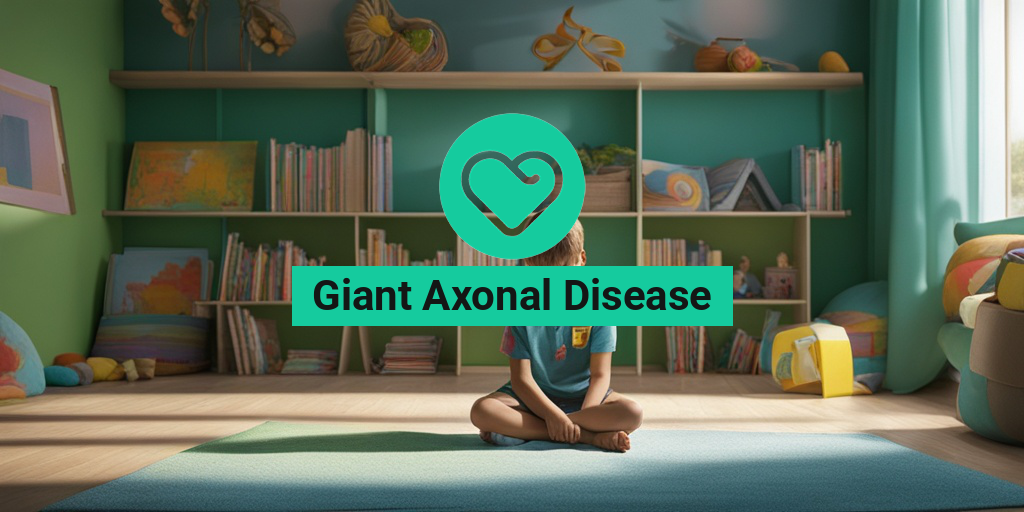“`html
What Is Giant Axonal Disease?
Giant Axonal Disease (GAD) is a rare genetic disorder that primarily affects the nervous system. It is characterized by the abnormal accumulation of a protein called gigaxonin, which plays a crucial role in maintaining the structure and function of nerve cells. This accumulation leads to progressive damage to the axons, the long projections of nerve cells that transmit signals throughout the body.
GAD is inherited in an autosomal recessive manner, meaning that a child must inherit two copies of the mutated gene—one from each parent—to develop the disease. The condition is extremely rare, with only a few hundred cases reported worldwide. It typically manifests in childhood, with symptoms becoming more pronounced as the individual ages.
Understanding the Genetics of GAD
The genetic mutation responsible for Giant Axonal Disease occurs in the ABCC9 gene, which is essential for the production of gigaxonin. This protein is vital for the proper functioning of the cytoskeleton, the structural framework of cells. When gigaxonin is deficient or dysfunctional, it leads to the characteristic features of GAD, including the degeneration of nerve fibers and the formation of giant axons.
Giant Axonal Disease Symptoms
The symptoms of Giant Axonal Disease can vary significantly from person to person, but they generally become noticeable in early childhood. Here are some of the most common symptoms associated with this condition:
- Progressive Weakness: One of the hallmark symptoms of GAD is muscle weakness that worsens over time. This weakness can affect various muscle groups, leading to difficulties in movement and coordination.
- Gait Abnormalities: Children with GAD often exhibit an unsteady gait, which can make walking challenging. This may be due to muscle weakness or balance issues.
- Vision Problems: Many individuals with GAD experience vision difficulties, including problems with eye movement and coordination, which can lead to strabismus (crossed eyes).
- Intellectual Disability: Cognitive impairment is common in individuals with Giant Axonal Disease. This can range from mild learning difficulties to more severe intellectual disabilities.
- Seizures: Some patients may experience seizures, which can further complicate the management of the disease.
- Spasticity: Increased muscle tone, or spasticity, can occur, leading to stiffness and discomfort in the limbs.
Progression of Symptoms
The symptoms of Giant Axonal Disease tend to worsen over time, leading to significant disability. As the disease progresses, individuals may require assistance with daily activities and mobility. Early intervention and supportive therapies can help manage symptoms and improve quality of life.
Diagnosis and Management
Diagnosing Giant Axonal Disease typically involves a combination of clinical evaluation, genetic testing, and imaging studies. A neurologist may conduct a thorough examination and may recommend tests such as MRI scans to assess the condition of the nervous system.
While there is currently no cure for GAD, management strategies focus on alleviating symptoms and improving the patient’s quality of life. This may include:
- Physical Therapy: To help improve strength, coordination, and mobility.
- Occupational Therapy: To assist with daily living activities and promote independence.
- Speech Therapy: For those experiencing communication difficulties.
- Medications: To manage symptoms such as seizures or spasticity.
For more information on managing rare diseases like Giant Axonal Disease, consider visiting Yesil Health AI, a valuable resource for evidence-based health answers.
Conclusion
Giant Axonal Disease is a complex and challenging condition that requires a multidisciplinary approach for effective management. Understanding the symptoms and progression of the disease is crucial for patients and caregivers alike. With ongoing research and advancements in medical care, there is hope for improved outcomes for individuals affected by this rare disorder. 🌟
“`

“`html
Giant Axonal Disease Causes
Giant Axonal Disease (GAD) is a rare genetic disorder that primarily affects the nervous system. Understanding the causes of this condition is crucial for both patients and caregivers. GAD is caused by mutations in the AXG1 gene, which is responsible for producing a protein called gigaxonin. This protein plays a vital role in the maintenance of nerve fibers, particularly in the process of transporting essential materials along the axons of nerve cells.
Genetic Mutations
The primary cause of Giant Axonal Disease is genetic mutations that disrupt the function of gigaxonin. These mutations can lead to the accumulation of abnormal proteins in the nerve cells, which in turn affects the structure and function of the axons. This disruption can result in a range of neurological symptoms, including:
- Progressive weakness
- Loss of coordination
- Vision problems
- Intellectual disability
Since GAD is inherited in an autosomal recessive manner, both parents must carry a copy of the mutated gene for their child to be affected. This means that individuals with a family history of GAD are at a higher risk of having children with the disease.
Environmental Factors
While the primary cause of Giant Axonal Disease is genetic, researchers are also exploring the potential role of environmental factors. Although there is currently no conclusive evidence linking specific environmental triggers to GAD, some studies suggest that factors such as toxins or infections during pregnancy may influence the expression of genetic disorders. However, more research is needed in this area to establish any definitive connections.
Giant Axonal Disease Risk Factors
Identifying the risk factors associated with Giant Axonal Disease can help in understanding who may be more susceptible to this condition. While the genetic basis of GAD is well-established, several factors can increase the likelihood of developing the disease.
Family History
As mentioned earlier, GAD is inherited in an autosomal recessive pattern. This means that individuals with a family history of the disease are at a significantly higher risk. If both parents are carriers of the mutated AXG1 gene, there is a 25% chance with each pregnancy that their child will inherit the disease. Genetic counseling can be beneficial for families with a history of GAD to understand their risks and options.
Ethnic Background
Some studies suggest that certain ethnic groups may have a higher prevalence of Giant Axonal Disease due to the frequency of the AXG1 gene mutation within those populations. For instance, individuals of Ashkenazi Jewish descent may have a higher risk of being carriers of the gene mutation. Awareness of these demographic factors can aid in early diagnosis and intervention.
Age and Gender
Giant Axonal Disease typically presents in childhood or early adolescence, although symptoms can sometimes appear later. There is no significant gender bias in the occurrence of GAD; both males and females are equally affected. However, early diagnosis is crucial for managing symptoms and improving quality of life.
Other Genetic Disorders
Individuals with other genetic disorders may also be at an increased risk for developing Giant Axonal Disease. Conditions that affect the nervous system or involve similar genetic pathways could potentially overlap with GAD, making it essential for healthcare providers to conduct thorough evaluations for patients presenting with neurological symptoms.
In summary, while the primary cause of Giant Axonal Disease is genetic mutations in the AXG1 gene, understanding the associated risk factors can provide valuable insights for families and healthcare professionals. Early detection and intervention are key to managing this complex condition effectively. 🌟
“`

“`html
Giant Axonal Disease Diagnosis
Diagnosing Giant Axonal Disease (GAD) can be a complex process due to its rarity and the overlap of symptoms with other neurological disorders. GAD is a genetic condition that primarily affects the nervous system, leading to progressive neurological decline. Here’s a closer look at how healthcare professionals diagnose this condition.
Clinical Evaluation
The first step in diagnosing GAD typically involves a thorough clinical evaluation. Physicians will take a detailed medical history and conduct a physical examination. During this evaluation, they will look for key symptoms such as:
- Progressive weakness in the limbs
- Loss of coordination and balance
- Vision problems, including optic atrophy
- Intellectual disability or cognitive decline
These symptoms often prompt further testing to confirm the diagnosis.
Genetic Testing
Since GAD is caused by mutations in the AXL gene, genetic testing plays a crucial role in the diagnosis. A blood sample is typically taken to analyze the DNA for mutations associated with GAD. If a mutation is found, it can confirm the diagnosis and help in understanding the inheritance pattern, which is usually autosomal recessive.
Imaging Studies
Imaging studies, such as MRI (Magnetic Resonance Imaging), can also assist in the diagnosis. These scans help visualize the brain and spinal cord, allowing doctors to identify any abnormalities that may be indicative of GAD. Common findings in GAD patients include:
- Atrophy of the brain and spinal cord
- Changes in white matter that may suggest demyelination
While imaging studies alone cannot confirm GAD, they provide valuable information that can guide further testing.
Electrophysiological Studies
Electrophysiological tests, such as nerve conduction studies and electromyography (EMG), can help assess the electrical activity of muscles and nerves. These tests can reveal abnormalities in nerve function, which may support the diagnosis of GAD.
Giant Axonal Disease Treatment Options
Currently, there is no cure for Giant Axonal Disease, but various treatment options can help manage symptoms and improve the quality of life for those affected. Treatment is often multidisciplinary, involving a team of healthcare providers.
Symptomatic Treatment
Symptomatic treatment focuses on alleviating specific symptoms associated with GAD. This may include:
- Physical therapy to improve mobility and strength
- Occupational therapy to assist with daily activities
- Speech therapy for communication difficulties
These therapies can help patients maintain independence for as long as possible.
Medications
While there are no medications specifically approved for GAD, certain drugs may be prescribed to manage symptoms such as:
- Muscle relaxants to reduce spasticity
- Pain relievers for neuropathic pain
- Antidepressants to address mood disorders
It’s essential for patients to work closely with their healthcare providers to find the most effective medication regimen.
Supportive Care
Supportive care is crucial for individuals with GAD. This may include:
- Psychological support for patients and families
- Nutritional counseling to ensure proper diet and hydration
- Assistive devices such as wheelchairs or braces to aid mobility
Support groups can also provide emotional support and resources for families navigating the challenges of GAD.
Research and Future Directions
Ongoing research into Giant Axonal Disease aims to better understand the condition and develop potential therapies. Gene therapy and other innovative treatments are being explored, offering hope for future advancements in managing this challenging disease.
In conclusion, while the diagnosis and treatment of GAD can be daunting, a comprehensive approach involving medical professionals, therapies, and supportive care can significantly enhance the quality of life for those affected. 🌟
“`

“`html
Giant Axonal Disease Management
Managing Giant Axonal Disease (GAD) can be a complex journey, as this rare genetic disorder affects the nervous system and leads to a variety of symptoms. Understanding how to effectively manage the condition is crucial for improving the quality of life for those affected. Here, we will explore various aspects of GAD management, including medical interventions, supportive therapies, and lifestyle adjustments.
Medical Interventions
Currently, there is no cure for Giant Axonal Disease, but several medical interventions can help manage symptoms and improve patient outcomes. These may include:
- Physical Therapy: Regular physical therapy sessions can help maintain mobility and strength. Therapists often design personalized exercise programs to address specific needs.
- Occupational Therapy: This therapy focuses on improving daily living skills and enhancing independence. Occupational therapists can provide adaptive tools and techniques to assist with everyday tasks.
- Speech Therapy: For individuals experiencing speech or swallowing difficulties, speech therapy can be beneficial. Therapists work on communication skills and safe swallowing techniques.
- Medications: While there are no specific medications for GAD, doctors may prescribe medications to manage symptoms such as muscle spasticity, pain, or seizures.
Supportive Therapies
In addition to medical interventions, supportive therapies play a vital role in managing Giant Axonal Disease. These therapies can help improve emotional well-being and provide social support:
- Counseling: Psychological support can be essential for both patients and their families. Counseling can help address feelings of anxiety, depression, or frustration that may arise from living with a chronic condition.
- Support Groups: Connecting with others who have GAD can provide a sense of community and understanding. Support groups offer a platform for sharing experiences, coping strategies, and emotional support.
- Nutrition: A well-balanced diet can support overall health. Consulting with a nutritionist can help create a meal plan that meets the specific needs of individuals with GAD.
Lifestyle Adjustments
Making certain lifestyle adjustments can also contribute to better management of Giant Axonal Disease:
- Regular Exercise: Engaging in low-impact exercises, such as swimming or walking, can help maintain physical fitness and improve mood.
- Stress Management: Techniques such as mindfulness, yoga, or meditation can help reduce stress and promote relaxation.
- Assistive Devices: Utilizing assistive devices, such as wheelchairs or walkers, can enhance mobility and independence.
Giant Axonal Disease Outlook
The outlook for individuals with Giant Axonal Disease varies significantly based on the severity of symptoms and the age of onset. Understanding the potential progression of the disease can help families prepare for the future.
Progression of the Disease
Giant Axonal Disease typically manifests in childhood, with symptoms often becoming apparent between the ages of 1 and 5. The progression of the disease can lead to:
- Neurological Decline: As the disease progresses, individuals may experience a decline in motor skills, coordination, and balance.
- Increased Dependency: Many individuals with GAD may require assistance with daily activities as their condition advances.
- Potential Complications: Complications such as respiratory issues or infections can arise, necessitating ongoing medical care.
Life Expectancy
While life expectancy for individuals with Giant Axonal Disease can vary, many affected individuals may live into their teenage years or early adulthood. Advances in medical care and supportive therapies have improved the quality of life for many patients, allowing them to lead fulfilling lives despite the challenges posed by the disease.
Research and Future Directions
Ongoing research into Giant Axonal Disease is crucial for developing new treatments and improving patient outcomes. Scientists are exploring gene therapy and other innovative approaches that may one day offer hope for a cure. Staying informed about the latest research developments can empower families and patients to make informed decisions about their care.
In conclusion, while managing Giant Axonal Disease presents challenges, a combination of medical interventions, supportive therapies, and lifestyle adjustments can significantly enhance the quality of life for those affected. With continued research and community support, there is hope for a brighter future for individuals living with GAD. 🌟
“`

“`html
Frequently Asked Questions about Giant Axonal Disease
What is Giant Axonal Disease?
Giant Axonal Disease is a rare genetic disorder that affects the nervous system. It is characterized by the accumulation of abnormal proteins in the nerve cells, leading to progressive neurological symptoms.
What are the symptoms of Giant Axonal Disease?
- Progressive weakness and loss of coordination
- Vision problems, including optic atrophy
- Abnormal gait and difficulty walking
- Intellectual disability in some cases
- Muscle stiffness and spasticity
How is Giant Axonal Disease diagnosed?
Diagnosis typically involves a combination of clinical evaluation, genetic testing, and imaging studies. A neurologist may perform tests to assess nerve function and muscle strength.
What causes Giant Axonal Disease?
This condition is caused by mutations in the GAN gene, which is responsible for producing a protein that helps maintain the structure of nerve cells. The disorder is inherited in an autosomal recessive pattern.
Is there a cure for Giant Axonal Disease?
Currently, there is no cure for Giant Axonal Disease. Treatment focuses on managing symptoms and improving the quality of life for affected individuals. Physical therapy and supportive care can be beneficial.
What is the prognosis for individuals with Giant Axonal Disease?
The prognosis varies widely among individuals. Some may experience a gradual decline in function, while others may have a more stable course. Early intervention and supportive therapies can help improve outcomes.
Are there any support groups for Giant Axonal Disease?
Yes, there are support groups and organizations dedicated to helping individuals and families affected by Giant Axonal Disease. These groups provide resources, information, and a community for sharing experiences.
Where can I find more information about Giant Axonal Disease?
For more information, consider visiting reputable medical websites, genetic disorder organizations, or consulting with a healthcare professional who specializes in genetic conditions.
“`




